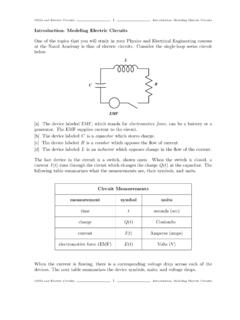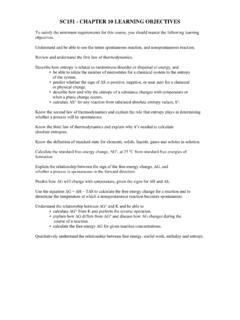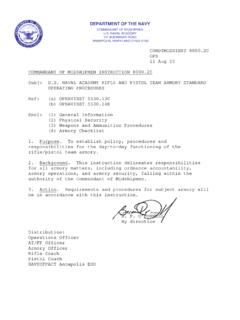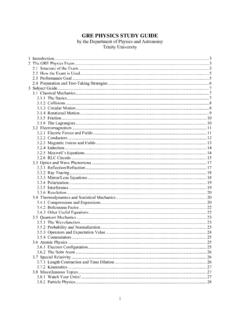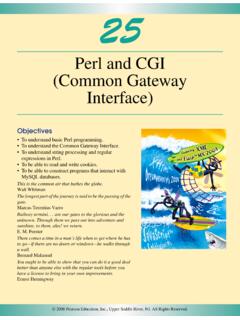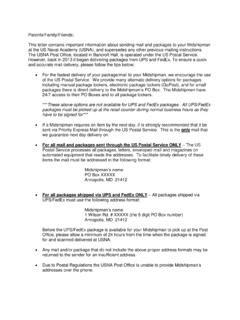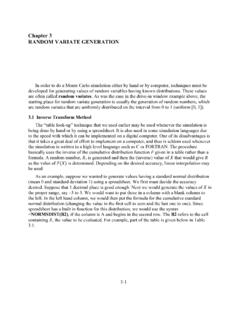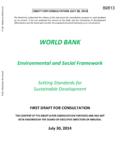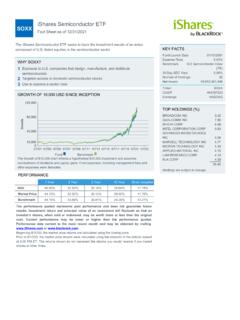Transcription of Laminate Analysis and Design - United States Naval Academy
1 2003, P. JoyceFailure, Analysis and DesignFailure, Analysis and Design 2003, P. JoyceSpecial Cases of LaminatesSpecial Cases of Laminates The symmetry or antisymmetryof a Laminate , based on angle, material, and thickness of plies, may zero out some elements of the three stiffness matrices [A], [B], and [D]. These are important to study because they may result in reducing or zeroing out the coupling of forces and bending moments, normal and shear forces, or bending and twisting moments. This not only simplifies the mechanical Analysis , but also gives desired mechanical performance. 2003, P. JoyceSymmetric LaminatesSymmetric Laminates It can be proved that the coupling matrix [B] = 0 for symmetric laminates. Hence the force and moment equations can be decoupled. = = xyyxxyyxxyyxxyyxDDDDDDDDDMMMAAAAAAAAANNN 662616262212161211000662616262212161211 2003, P.
2 JoyceSymmetric LaminatesSymmetric Laminates If a symmetric Laminate is subjected only to forces, it will have zero midplane curvatures. If it is subjected only to moments it will have zero midplane strains. Makes Analysis much simpler. Also prevents a Laminate from twisting due to thermal loads. 2003, P. JoyceCrossCross--Ply LaminatesPly Laminates For cross-ply laminates A16= A26= B16= B26= D16= D 26= 0. = xyyxxyyxxyyxxyyxDBDDBBDDBBBABBAABBAAMMMN NN 0006666221222121211121166662212221212111 2110000000000000000 Hence, there is uncoupling between the normal and shear forces, and also between the bending and twisting moments. If a cross-ply is also symmetric, then [B] = 0 and there will no coupling between the force and moment terms. 2003, P. JoyceAngleAngle--Ply LaminatesPly Laminates If an angle-ply Laminate has an even number of plies, then A16= A26= 0.
3 If the number of plies is odd, and it consists of alternating + and plies, then not only is it symmetric ([B] = 0), but also A16, A26, D16, D26 0 as the number of layers increases for the same Laminate thickness. Similar to symmetric cross-ply laminates, but with higher shear stiffness and shear strength properties. 2003, P. JoyceAntisymmetric Antisymmetric LaminatesLaminates A Laminate is called antisymmetric if the material and thickness of the plies are the same above and below the midplane, but the ply orientations at the same distance above and below the midplane are negative of each other, +45/60/-60/-45. = xyyxxyyxxyyxxyyxDBBBDDBBBDDBBBBBBABBBAAB BBAAMMMNNN 0006666261622122622121211161211662616662 622122212161211121100000000 2003, P. JoyceBalanced LaminatesBalanced Laminates A Laminate is balanced when it consists of pairs of layers of the same thickness and material where the angles of the plies are + and.
4 Thus A16= A26= 0. = xyyxxyyxxyyxxyyxDDDBBBDDDBBBDDDBBBBBBABB BAABBBAAMMMNNN 0006626166626162622122622121612111612116 6261666262212221216121112110000 If the number of plies in a balanced Laminate is odd, it an be made symmetric ([B] = 0). 2003, P. JoyceQuasiQuasi--Isotropic LaminatesIsotropic Laminates A Laminate is called quasi-isotropic if its extensional stiffness matrix [A] behaves like that of an isotropic material. This not only implies A11= A22, A16=A26, and A66=(A11-A12)/2, but also that these stiffnesses are independent of the angle of rotation of the Laminate . Called quasi-isotropic and not isotropic because [B] and [D] may not behave like an isotropic material. Examples of quasi-isotropic laminates include[0/ 60], [0/ 45/90]s, [0/36/72/-18/-54] 2003, P. JoyceFailure Criteria for a LaminateFailure Criteria for a Laminate Laminate failure may not be catastrophic.
5 It is possible that some layer(s) fail first and the composite continues to take more loads until all the plies fail. Failed plies may still contribute to the stiffness and strength of the Laminate . 2003, P. JoyceFailure Criteria for a LaminateFailure Criteria for a Laminate The degradation of the stiffness and strength properties of each failed lamina depends on the philosophy of the user: When a ply fails, it may have cracks parallel to the fibers. This ply is still capable of taking load parallel to the fibers. The longitudinal modulus and strength remain unchanged, the transverse stiffness and strength as well as the shear strength 0. When a ply fails, fully discount the ply and replace the ply of near-zero stiffness and strength. 2003, P. JoyceFailure Criteria for a LaminateFailure Criteria for a Laminate Procedure for finding the successive loads between first ply failure and last ply failure (following the fully discounted method) Use CLT to find the midplane strains and curvatures given the applied load.
6 Find the local stresses and strains in each ply. Apply the failure theories to each ply to determine the strength ratio(SR) for each ply. Multiplying the strength ratio to the applied load gives the load level of the failure of the first ply. Degrade fully the stiffness of damaged ply or plies. Apply the actual load level of the previous failure. Repeat to find the (SR)for the undamaged plies. If the SR>1, multiply to the applied load to obtain the load level of the next ply failure and repeat. If the SR<1, degrade the stiffness and strength properties of all the damaged plies and apply the actual load level of the previous failure. Repeat until all of the plies have failed. The load at which all of the plies have failed is called the last ply failure. 2003, P. JoyceStrength RatioStrength Ratio In a failure theory, it can be determined whether a lamina has failed if the stress state lies within the failure envelope.
7 However, it does not give information about how much the load can be increased if the lamina is safe, or how much the load should be decreased if the lamina has failed. The strength ratio is defined If SR>1, then the lamina is safe and the applied stress can be increased by a factor of SR. If SR<1, the lamina is unsafe and the applied stress needs to bereduced by a factor of LoadApplied BeCan Which Load Maximum=SR 2003, P. JoyceExample ProblemExample Problem A [0/90]s Laminate made of glass/epoxy is subjected to an axial load Nx(assume each layer is thick.). Determine the first ply failure load (or stress) 2003, P. JoyceExample ProblemExample Problem 45% fiber volume fraction glass/epoxy composite E1= Msi, E2= Msi, G12= Msi 12= , Compute reduced stiffness terms for each layer, == Msi1 EQEQEQ == == == MsiG== 2003, P.
8 JoyceExample ProblemExample Problem Compute transformed reduced stiffness matrices for each layer[] == = 2003, P. JoyceExample ProblemExample Problem Compute extensional stiffness matrix, [A] Compute extensional compliance matrix Laminate is symmetric so [a] = [A]-1[] (10) (10)0() (10) (10) (10)xykkkkAQzz = = = [] (10) (10) (10) (10) (10)a = 2003, P. JoyceExample ProblemExample Problem From symmetry, [B] = 0, thus midplane strains and curvatures are decoupled. assuming, Nx= 1 lb/in., and Ny= Nxy= Mx= My= Mxy=0.[] (10) (10) == 2003, P. JoyceExample ProblemExample Problem Similarly for the curvatures,[][][]1but 0010 = = = 2003, P. JoyceExample ProblemExample Problem Compute the global strains at the top surface of the first 0 ply.
9 Same at the bottom surface Same everywhere in the Laminate .[][][][] (10) (10)0z =+ = 2003, P. JoyceExample ProblemExample Problem Compute the global stresses at the top surface of the first 0 ply. Find transformation matrix for each ply angle.[][] == [][]090100010010 100001001TT == DD 2003, P. JoyceExample ProblemExample Problem Compute the local stresses at the top surface of the first 0 ply. Same throughout the first 0 ply and the other 0 ply. Similarly for the 90 plies[] psi0 = [] psi0 = 2003, P. JoyceExample ProblemExample Problem Compute strength ratios for all 4 plies SR0= 1502 SR90= 259 Then Nx@ FPF = 259 psi-in. Failure initiates in the 90 plies (as expected.) Maximum allowable normal stress @ ksixNh= 2003, P. JoyceDesign ConsiderationsDesign Considerations Design of laminated composites includes selecting a material system or a group of material systems and determining the stacking sequence for the Laminate based on applied loads, and constraints on optimizing and constraining factors such as Cost Mass Stiffness Dimensional Stability List is similar to that used in designing with monolithic materials; the main issue then comes of understanding the orthotropic nature of composite plies.
10 2003, P. JoyceDesign ConsiderationsDesign Considerations The possibility of different fiber/matrix systems combined with the variables such as Vfdictates the properties of a lamina. Then laminae can be placed at angles and at particular distances from the midplane of the Laminate . The material systems and the stacking sequence determine the stresses and strains in the Laminate . 2003, P. JoyceDesign ConsiderationsDesign Considerations Failure may be based on first ply failureor last ply failure. Laminate selection is a computationally intensive and repetitive task due to the many possibilities of fiber/matrix combinations, material systems, and stacking sequence. 2003, P. JoyceOther Mechanical Design IssuesOther Mechanical Design Issues Hygrothermal Effects Long-Term environmental Effects Interlaminar Stresses Impact Resistance Fracture Resistance Fatigue Resistance 2003, P.
